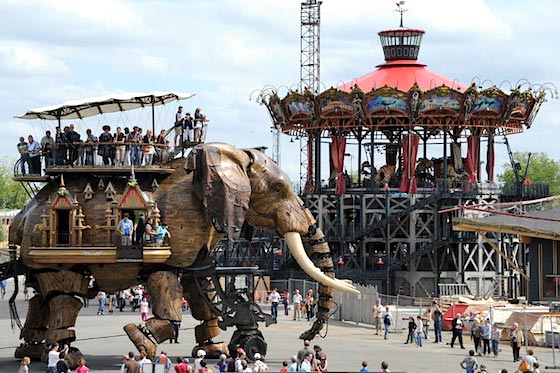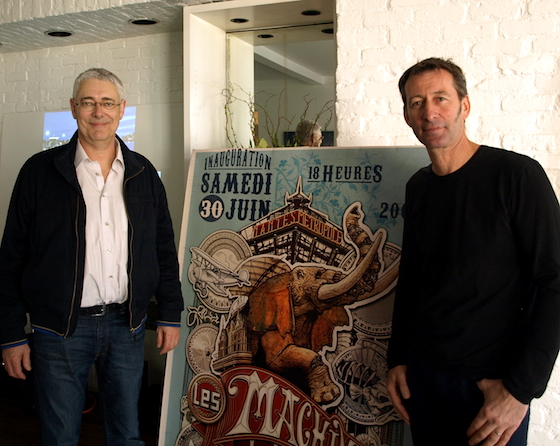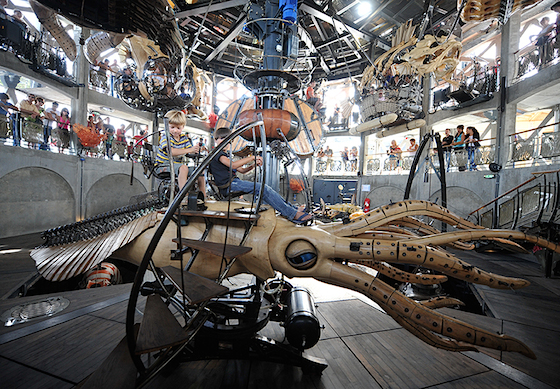
The Themed Entertainment Association, one of in the industry's leading groups of creative professionals, this weekend is honoring Le Carrousel des Mondes Marins (Marine Worlds Carousel) at Les Machines de I'lle in Nantes with a Thea Award for Unique Art Installation. Today in Beverly Hills, the Consul general of France in Los Angeles hosted Pierre Orefice and Francois Delaroziere, the creators of the carousel and the Nantes project.

In promotional materials, the carousel is pictured, bobbing in the stormy sea, yet against blue skies. It's an apt image for an area that was once a shipyard but was since 1987 in a state of abandonment and decline. Orefice said that he likes to think that, for residents of Nantes, the sight of the carousel's red circus top is a symbol that "life isn't so serious, the city isn't so serious -- life is much softer and sweeter."

"It stands on the banks of the Loire River, opposite the house where Jules Verne grew up," Orefice said. "The theme of the sea came to us naturally, because the sea has no limits. We [illustrate] its spirit with sailor stories and the fantastical creatures. It is an imaginary world shared by all."

The 35 sea creatures in the three-level carousel are each mechanical contraptions, with wheels and gears and pedals for riders to operate. As the old shipyard buildings on the project site have been re-designed and stripped to their support structures, these fish and sea creatures are "machines" that show their bones and their teeth; they are not the smiling animals in candy colors one might expect on a typical theme park carousel.
It is whismy within an industrial frame, acknowledging the area's history while inspiring visitors to look beyond it. If the English (and American) tradition is to hide the "downstairs" service from the "upstairs" elite, the French won't hesitate to celebrate art alongside its gritty industrial foundation. (Just take another look at the iconic Centre Pompidou in Paris.)
The Les Machines de I'lle project that houses the carousel is at its heart more an art installation than what fans might typically consider theme park. Its original project, opened in 2007, was a giant mechanical elephant that carries 50 riders through the city streets several times a day.
"It's like architecture in movement, throughout the city," Delaroziere said of the elephant, and that ties in with France's long tradition of public art, and of street performing. The elephant is like a sculpture in motion, day and night; you can see him and touch him. He walks in the public streets and then he "sleeps" at night in one of the project buildings.
Because the displays are so interactive and so worked into the fabric of the city's everyday structures, they shake up daily life. "These projects perturb everyday life and cause people to interact differently, and to interact with each other," he said. What a perfect example of themed entertainment in action!
The people of Nantes understood that these displays would made the city more attractive not only to them, buy to potential tourists, and they gave Orefice and Delaroziere complete artistic freedom in their conception and construction. The two have worked together for some 20 years, since 1983. Both now live in Nantes. Each has his own projects, and then this collaboration brings them together. (Their teams took four years to build all 35 elements in the carousel.) Here is a video the two showed about the project:
In addition to the Marine Worlds Carousel, here are the other honorees at this year's Thea Awards, which will be presented in Anaheim this weekend:
The capacity for these attractions is not great. I'd have to go back and check my notes (not at home right now!), but one of the two said that the capacity for the elephant ride is just a few hundred people per day. And that the carousel capacity is just a couple hundred people per hour. The rides cost 8 euro each, so that's another way to limit the demand for the rides to what the project can handle.
They really function more as attraction-inspired art installations than pure attractions, as they're not the sort of things that scale well into a high-demand theme park. But they certainly should inspire attraction designers... as attraction design clearly has inspired the creators of these pieces.
This article has been archived and is no longer accepting comments.
"Themed entertainment isn't just for theme parks anymore. The lessons that creators of theme parks and their attractions have learned over half a century now influence artists and designers throughout the world."
The fair (where this art project partially gets it's inspiration from isn't the American kitsch called Disney Land but the fun fair that has been around in the middle ages and started somewhere around 1133 in Europe. The first steam powered carousel could be found in the 1860's (UK invention) but before that there where horses who walked around and pulled the ride.
When you look at the elephant it looks like a throw back to the elephant that could be seen in another theme park for adults venue, the Moulin Rouge (1889 (they started building the Eiffel tower too that year)). The elephant itself is a non exact replica of a elephant that was made for a theatre production in England but this one can carry 49 packagers for a 45 minute walk.
To credit US theme parks for inspiration of an art project in France is very ignorant. Again great article of a stunning and fun art project.